A Case for Buried Culture: From an Unknown Known to a Known Unknown
Abstract
:1. Introduction
2. Buried Culture as an Unknown Known: Landfills and Epistemic Limits
3. Between Archaeology and Sedimentology
4. A Way Forward: Aesthetics and Formal Analysis
4.1. The Case for Aesthetics
- A capacity to direct a culturally invested gaze at corporeal features of Buried Culture (e.g., form, composition, texture);
- An ability to deliver these features—with appropriate adjustments—for analysis without compromising our object’s (i.e., Buried Culture) integrity.
4.2. Towards an Application of Aesthetics to Buried Culture
5. A Case Study: Mikve Israel Landfill
5.1. Artifactual Density
5.2. Assemblage Composition
- Segments containing admixtures with a clear leaning towards glass;
- Segments containing admixtures with a strong leaning towards metal, stone, or a combination of the two;
- Segments containing ‘generic’ or widely dispersed admixtures, marked by a balanced presence of at least three substance categories and possibly more.
5.3. Towards an Aesthetics Appreciation of Mikve Israel Landfill
6. Discussion
- Rather than locating Buried Culture on a trajectory of increasing entropy (disorder), the proposed framework conceives it as an emergent new being. By this token, processes hitherto considered negative and destructive become positive and creative.
- Instead of employing analytical procedures that prioritize the articulation of process and temporality, the proposed approach directs analysis at questions of form.
Funding
Acknowledgments
Conflicts of Interest
References
- Howard, J. Anthropogenic Soils; Springer: Cham, Switzerland, 2017. [Google Scholar]
- Edgeworth, M. Grounded objects. Archaeology and speculative realism. Archaeol. Dialogues 2016, 23, 93–113. [Google Scholar] [CrossRef]
- Capelotti, P.J. Surveying Fermi’s Paradox, mapping Dyson’s Sphere: Approaches to archaeological field research in space. In Handbook of Space Engineering: Archaeology and Heritage; Darrin, A.G., O’Leary, B.L., Eds.; CRC Press: Boca Raton, FL, USA, 2009; pp. 857–869. [Google Scholar] [CrossRef]
- Edgeworth, M. More than just a record: Active ecological effects of archaeological strata. In Historical Archaeology and Environment; de Souza, M.A.T., Costa, D.M., Eds.; Springer: Cham, Switzerland, 2018; pp. 19–40. [Google Scholar]
- Žižek, S. Philosophy, the “unknown knowns,” and the public use of reason. Topoi 2006, 25, 137–142. [Google Scholar] [CrossRef]
- Foucault, M. Society Must be Defended: Lectures at the Collège de France, 1975–76; Picador: New York, NY, USA, 2003. [Google Scholar]
- Polanyi, M. Personal Knowledge: Towards a Post-Critical Theory; University of Chicago Press: Chicago, IL, USA, 1958. [Google Scholar]
- Bourdieu, P. The Logic of Practice; Stanford University Press: Stanford, CA, USA, 1990. [Google Scholar]
- Latour, B. Science in Action; Harvard University Press: Cambridge, MA, USA, 1987. [Google Scholar]
- Hird, M.J. Knowing Waste: Towards an Inhuman Epistemology. Soc. Epistem. 2012, 26, 453–469. [Google Scholar] [CrossRef]
- Reno, J. Waste Away: Working and Living with a North American Landfill; University of California Press: Oakland, CA, USA, 2016. [Google Scholar]
- Reno, J. Your Trash Is Someone’s Treasure: The Politics of Value at a Michigan Landfill. J. Mater. Cult. 2009, 14, 29–46. [Google Scholar] [CrossRef]
- Thompson, M. Rubbish Theory: The Creation and Destruction of Value; Oxford University Press: Oxford, UK, 1979. [Google Scholar]
- Douglas, M. Purity and Danger: An Analysis of the Concepts of Pollution and Taboo; Routledge: London, UK, 1966. [Google Scholar]
- Kristeva, J. Powers of Horror: An Essay on Abjection; Columbia University Press: New York, NY, USA, 1982. [Google Scholar]
- Curtis, V.A. Dirt, disgust and disease: A natural history of hygiene. J. Epidemiol. Community Health 2007, 61, 660–664. [Google Scholar] [CrossRef] [PubMed]
- Hacking, I. The Social Construction of What? Harvard University Press: Cambridge, MA, USA, 1999. [Google Scholar]
- Rathje, W.L.; Murphy, C. Rubbish! The Archaeology of Garbage; The University of Arizona Press: Tucson, AZ, USA, 2001. [Google Scholar]
- Reno, J.O. Toward a New Theory of Waste: From “Matter out of Place” to Signs of Life. Theory Cult. Soc. 2014, 31, 3–27. [Google Scholar] [CrossRef] [Green Version]
- Lucas, G. Disposability and Dispossession in the Twentieth Century. J. Mater. Cult. 2002, 7, 5–22. [Google Scholar] [CrossRef]
- Gibson, J.J. The Ecological Approach to Visual Perception, Classic ed.; Psychology Press: New York, NY, USA, 2015. [Google Scholar] [CrossRef]
- Ingold, T. Materials against materiality. Archaeol. Dialogues 2007, 14, 1–16. [Google Scholar] [CrossRef] [Green Version]
- Nativ, A. On the object of archaeology. Archaeol. Dialogues 2018, 25, 1–21. [Google Scholar] [CrossRef] [Green Version]
- Rathje, W.L.; Hughes, W.W.; Wilson, D.C.; Tani, M.K.; Archer, G.H.; Hunt, R.G.; Jones, T.W. The Archaeology of Contemorary Landfills. Am. Antiq. 1992, 57, 437–447. [Google Scholar] [CrossRef]
- Sosna, D. Heterotopias behind the fence: Landfills as relational emplacements. In Archaeologies of Waste: Encounters with the Unwanted; Sosna, D., Brunclíková, L., Eds.; Oxbow Books: Oxford, UK, 2017; pp. 162–178. [Google Scholar]
- Holmberg, T.; Ideland, M. The circular economy of food waste: Transforming waste to energy through ‘make-up’ work. J. Mater. Cult. 2021, 26, 344–361. [Google Scholar] [CrossRef]
- Hird, M.J. Waste, Landfills, and an Environmental Ethic of Vulnerability. Ethic Environ. 2013, 18, 105–124. [Google Scholar] [CrossRef]
- Graff, R.S. Disposing of Modernity: The Archaeology of Garbage and Consumerism during Chicago’s 1893 World’s Fair; University Press of Florida: Gainesville, FL, USA, 2020. [Google Scholar]
- Stanley, J. Know How; Oxford University Press: Oxford, UK, 2011. [Google Scholar]
- Schiffer, M.B. Archaeological Context and Systemic Context. Am. Antiq. 1972, 37, 156–165. [Google Scholar] [CrossRef]
- Olivier, L. The Dark Abyss of Time: Archaeology and Memory; Rowman & Littlefield: Lanham, MD, USA, 2011. [Google Scholar]
- Olsen, B. Defense of Things: Archaeology and the Ontology of Objects; Altamira Press: Lanham, MD, USA, 2010. [Google Scholar]
- Dawdy, S.L. Clockpunk Anthropology and the Ruins of Modernity. Curr. Anthr. 2010, 51, 761–793. [Google Scholar] [CrossRef] [Green Version]
- Miller, D. (Ed.) Material Cultures: Why Some Things Matter; UCL Press: London, UK, 1998. [Google Scholar]
- Soto, G. Object Afterlives and the Burden of History: Between “Trash” and “Heritage” in the Steps of Migrants. Am. Anthr. 2018, 120, 460–473. [Google Scholar] [CrossRef]
- Edgeworth, M. Archaeology of the Anthropocene: Introduction. J. Contemp. Archaeol. 2014, 1, 73–77. [Google Scholar] [CrossRef]
- Dazzi, C.; Papa, G.L. Anthropogenic soils: General aspects and features. Ecocycles 2015, 1, 3–8. [Google Scholar] [CrossRef] [Green Version]
- Ford, J.R.; Price, S.J.; Cooper, A.H.; Waters, C.N. An assessment of lithostratigraphy for anthropogenic deposits. In A Stratigraphical Basis for the Anthropocene; Waters, C.N., Zalaseiwicz, J.A., Williams, M., Ellis, M.A., Snelling, A.M., Eds.; Geological Society Special Publications (No. 395); Geological Society of London: London, UK, 2014; pp. 55–89. [Google Scholar] [CrossRef] [Green Version]
- Zalasiewicz, J.; Williams, M.; Waters, C.N.; Barnosky, A.D.; Haff, P. The technofossil record of humans. Anthr. Rev. 2014, 1, 34–43. [Google Scholar] [CrossRef] [Green Version]
- Lucas, G. Critical Approaches to Fieldwork; Routledge: London, UK, 2001. [Google Scholar] [CrossRef]
- Schnapp, A. Between antiquarians and archaeologists—Continuities and ruptures. Antiquity 2002, 76, 134–140. [Google Scholar] [CrossRef]
- Schiffer, M.B. Formation Processes of the Archaeological Record; University of Utah Press: Salt Lake City, UT, USA, 1987. [Google Scholar]
- González-Ruibal, A. An Archaeology of the Contemporary Era; Routledge: London, UK, 2019. [Google Scholar]
- Graves-Brown, P.; Harrison, R.; Piccini, A. (Eds.) Oxford Handbook of Archaeology of the Contemporary World; Oxford University Press: Oxford, UK, 2013. [Google Scholar]
- Harrison, R. Surface assemblages. Towards an archaeology in and of the present. Archaeol. Dialogues 2011, 18, 141–161. [Google Scholar] [CrossRef]
- Pétursdóttir, Ϸ.; Olsen, B. (Eds.) An archaeology of ruins. In Ruin Memories: Materialities, Aesthetics and the Archaeology of the Recent Past; Routledge: London, UK, 2014; pp. 3–29. [Google Scholar]
- Shanks, M.; Platt, D.; Rathje, W.L. The Perfume of Garbage: Modernity and the Archaeological. Modernism/Modernity 2004, 11, 61–83. [Google Scholar] [CrossRef]
- Adams, W.Y.; Adams, E.W. Archaeological Typology and Practical Reality: A Dialectical Approach to Artifact Classification and Sorting; Cambridge University Press: Cambridge, UK, 1991. [Google Scholar]
- Nativ, A. Ambiguity, Ambivalence, Multiplicity: A Case Study of Late Pottery Neolithic Ceramic Assemblages from the Southern Levant. Camb. Archaeol. J. 2018, 28, 629–645. [Google Scholar] [CrossRef]
- Chang, H. Is Water H2O? Evidence, Realism and Pluralism; Springer: London, UK, 2012. [Google Scholar]
- Hacking, I. Representing and Intervening: Introductory Topics in the Philisophy of Natural Science; Cambridge University Press: Cambridge, UK, 1983. [Google Scholar]
- Latour, B.; Woolgar, S. Laboratory Life: The Construction of Scientific Facts; Princeton University Press: Princeton, NJ, USA, 1986. [Google Scholar]
- Pickering, A. The Mangle of Practice: Time, Agency and Science; The University of Chicago Press: Chicago, IL, USA, 1995. [Google Scholar]
- Bowker, G.C.; Star, S.L. Sorting Things Out: Classification and its Consequences; MIT Press: Cambridge, MA, USA, 1999. [Google Scholar]
- Pétursdóttir, Ϸ. Small Things Forgotten Now Included, or What Else Do Things Deserve? Int. J. Hist. Archaeol. 2012, 16, 577–603. [Google Scholar] [CrossRef] [Green Version]
- Lévi-Strauss, C. The Savage Mind; University of Chicago Press: Chicago, IL, USA, 1966. [Google Scholar]
- Houston, K. An Introduction to Art Criticism: Histories, Strategies, Voices; Pearson: Boston, MA, USA, 2013. [Google Scholar]
- Fichner-Rathus, L. Understanding Art, 11th ed.; Cengage Learning: Boston, MA, USA, 2017. [Google Scholar]
- Getlein, M. Living with Art, 9th ed.; McGraw-Hill: New York, NY, USA, 2010. [Google Scholar]
- Eppelbaum, L.V. Archaeological geophysics in Israel: Past, present and future. Adv. Geosci. 2010, 24, 45–68. [Google Scholar] [CrossRef] [Green Version]
- Renfrew, C.; Bahn, P. Archaeology: Theories, Methods, and Practice, 7th ed.; Thames & Hudson: London, UK, 2016. [Google Scholar]
- Balslev, Y. Hebrew town with Hebrew waste: The handling of Tel Aviv’s waste during the Mandate period. Israel 2016, 24, 271–300. (In Hebrew) [Google Scholar]
- Goodman, N. Ways of Worldmaking; Hackett Publishing Company: Indianapolis, IN, USA, 1978. [Google Scholar]
- Elkins, J. How to Use Your Eyes; Routledge: New York, NY, USA, 2000. [Google Scholar]
- Marcheselli, V. The Shadow Biosphere Hypothesis: Non-knowledge in Emerging Disciplines. Sci. Technol. Hum. Values 2020, 45, 636–658. [Google Scholar] [CrossRef]
- Harman, G. The Quadruple Object; Zero Books: Winchester, UK, 2011. [Google Scholar]
- Lyman, R.L. Vertebrate Taphonomy; Cambridge University Press: Cambridge, UK, 1994. [Google Scholar]
- Turner, D. Making Prehistory: Historical Science and the Scientific Realism Debate; Cambridge University Press: Cambridge, UK, 2007. [Google Scholar]
- Binford, L.R. Sampling, judgement and the archaeological record. In Sampling in Archaeology; Mueller, J.W., Ed.; University of Arizona Press: Tucson, AZ, USA, 1975; pp. 251–257. [Google Scholar]
- Binford, L.R. Behavioral Archaeology and the “Pompeii Premise”. J. Anthr. Res. 1981, 37, 195–208. [Google Scholar] [CrossRef]
- Collins, M.B. Sources of bias in processual data: An appraisal. In Sampling in Archaeology; Mueller, J.W., Ed.; University of Arizona Press: Tucson, AZ, USA, 1975; pp. 26–32. [Google Scholar]
- Lucas, G. Understanding the Archaeological Record; Cambridge University Press: Cambridge, UK, 2012. [Google Scholar]
- Murray, T. (Ed.) Time and Archaeology; One World; Routledge: London, UK, 1999. [Google Scholar] [CrossRef]
- Nativ, A. No Compensation Needed: On Archaeology and the Archaeological. J. Archaeol. Method Theory 2017, 24, 659–675. [Google Scholar] [CrossRef]
- LaCapra, D. Trauma, absence, loss. Crit. Inq. 1999, 25, 696–727. [Google Scholar] [CrossRef]
- Barad, K. Meeting the Universe Half Way: Quantum Physics and the Entanglement of Matter and Meaning; Duke University Press: Durham, NC, USA, 2007. [Google Scholar]
- Giddens, A. The Constitution of Society: Outline of the Theory of Structuration; University of California Press: Berkeley, CL, USA, 1984. [Google Scholar]
- Fowler, C.; Harris, O.J. Enduring relations: Exploring a paradox of new materialism. J. Mater. Cult. 2015, 20, 127–148. [Google Scholar] [CrossRef] [Green Version]
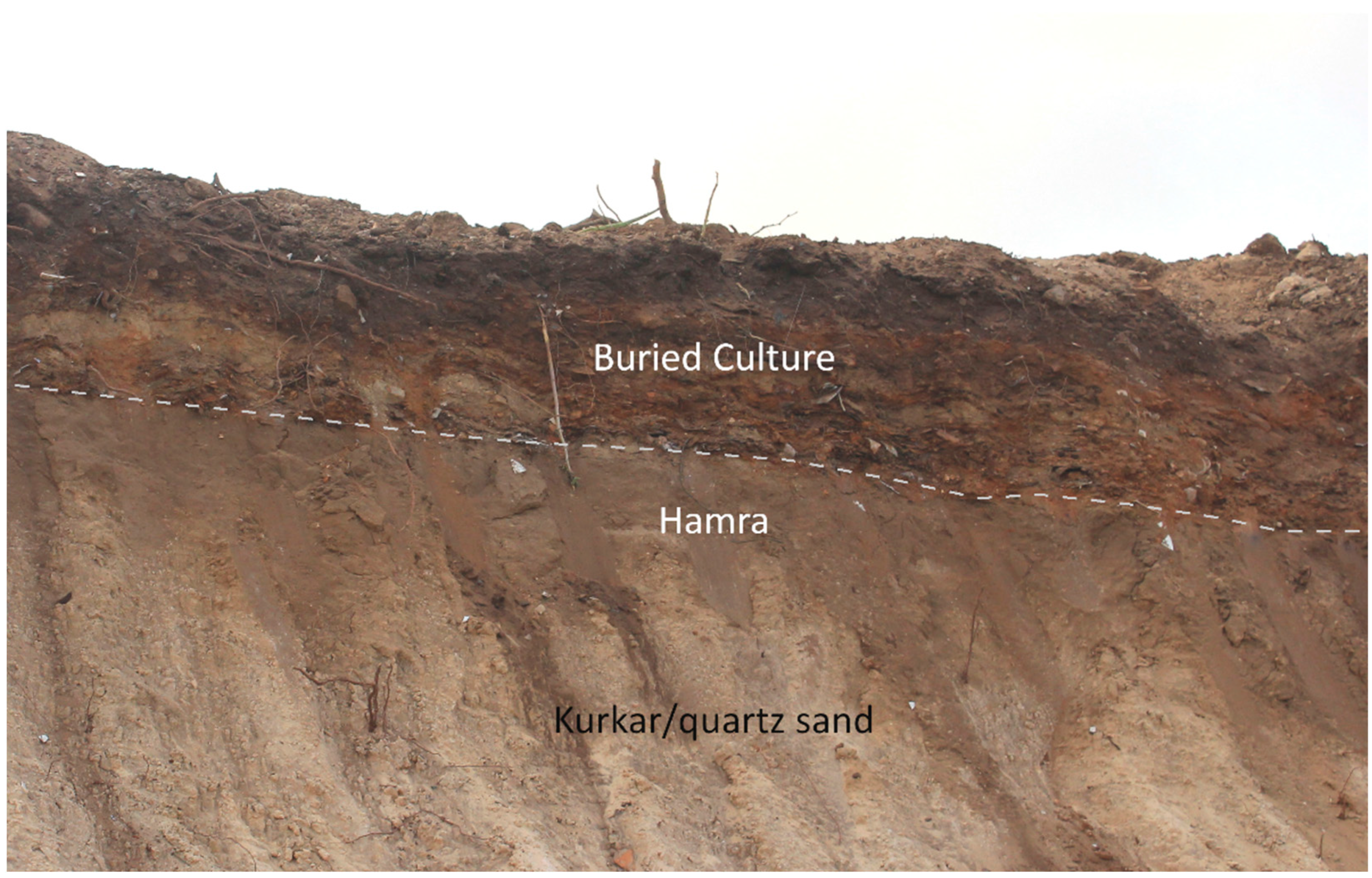
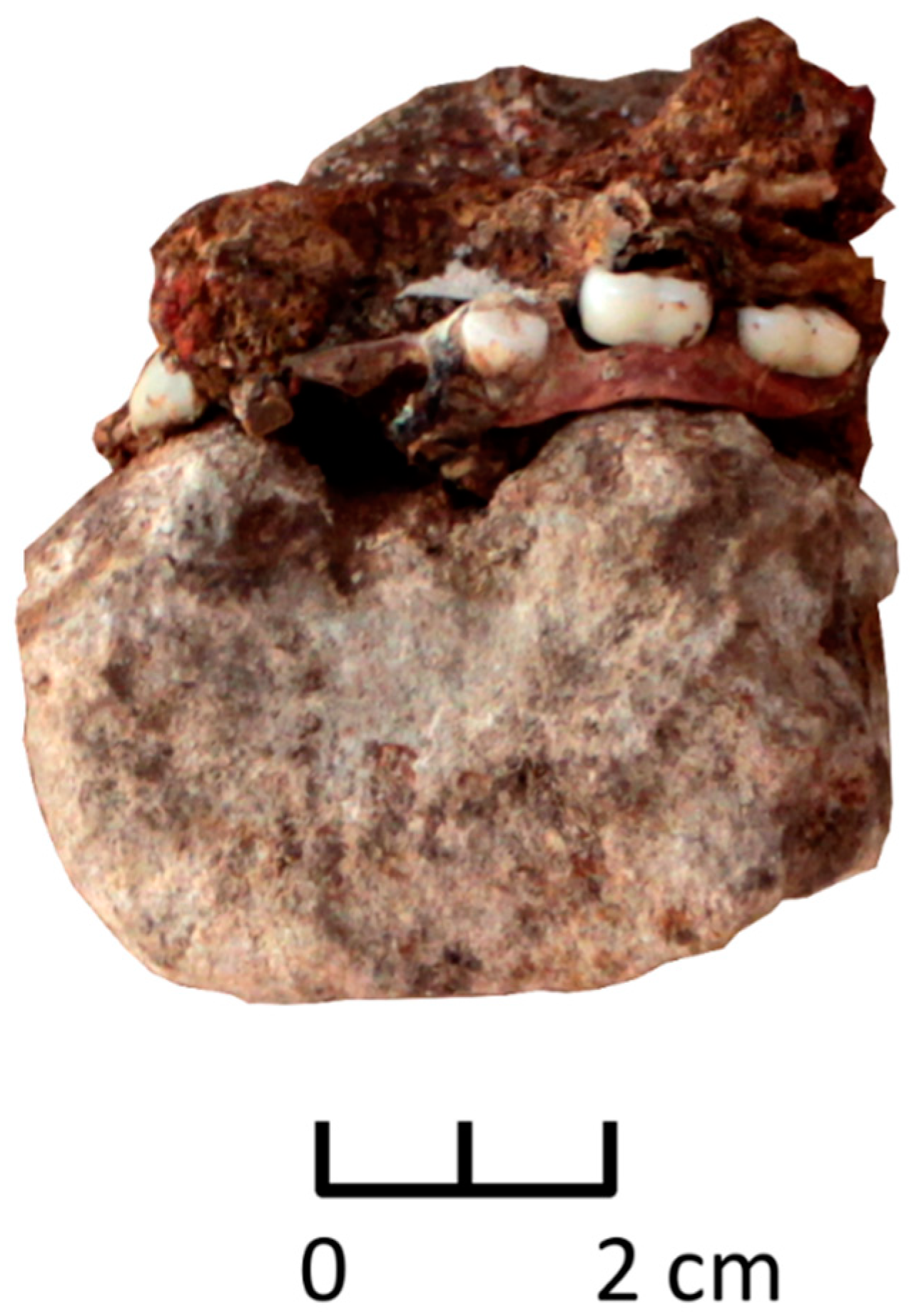
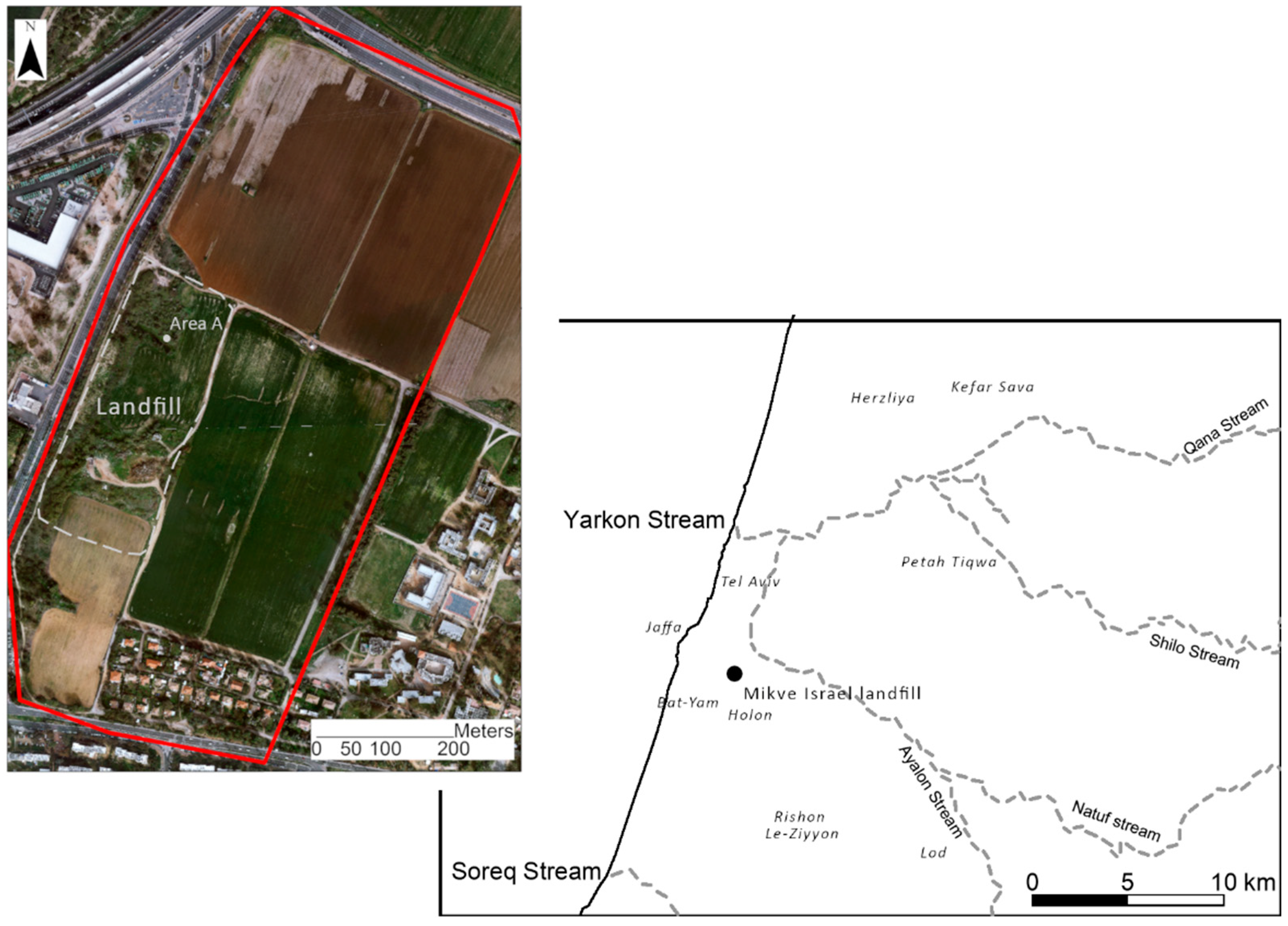
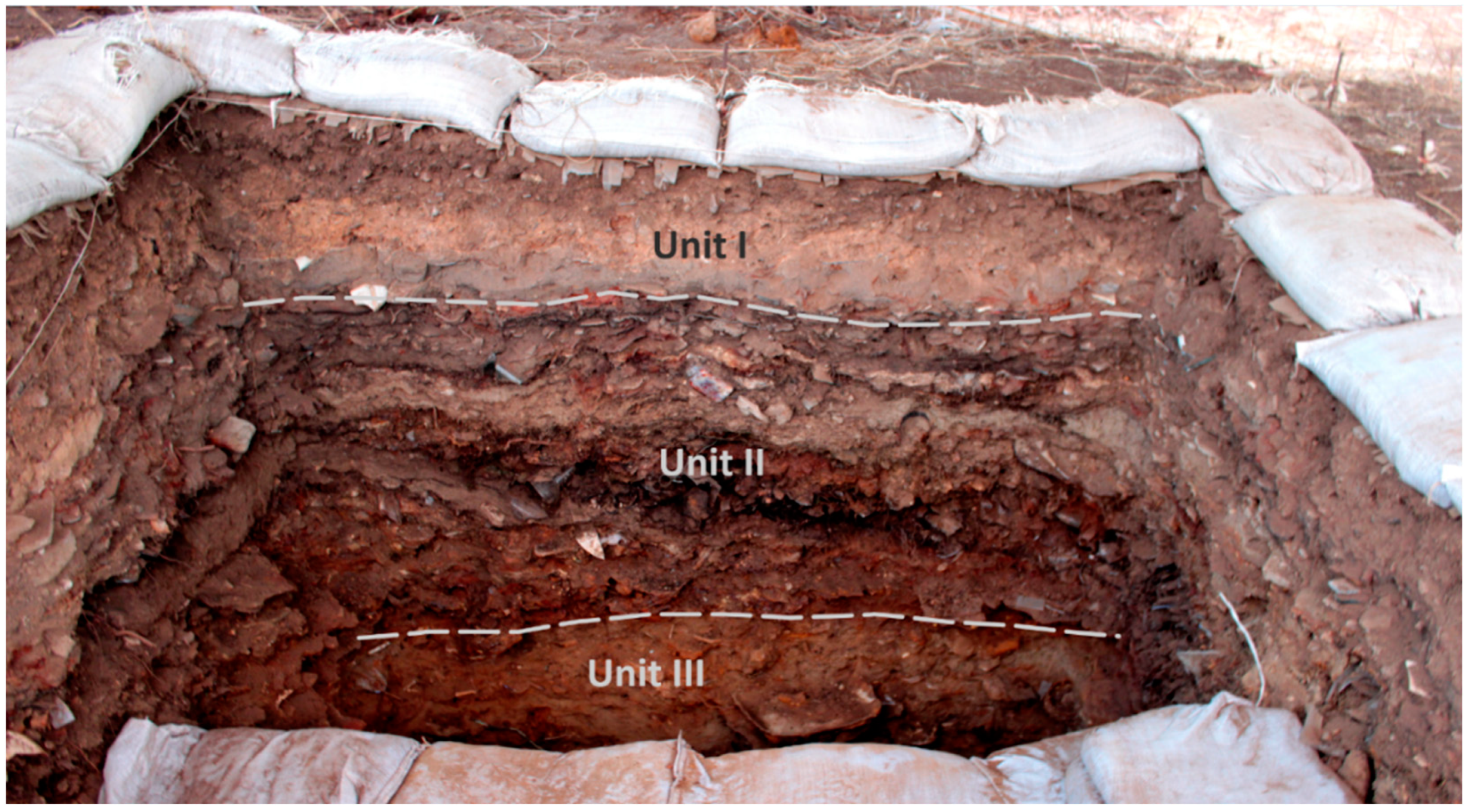
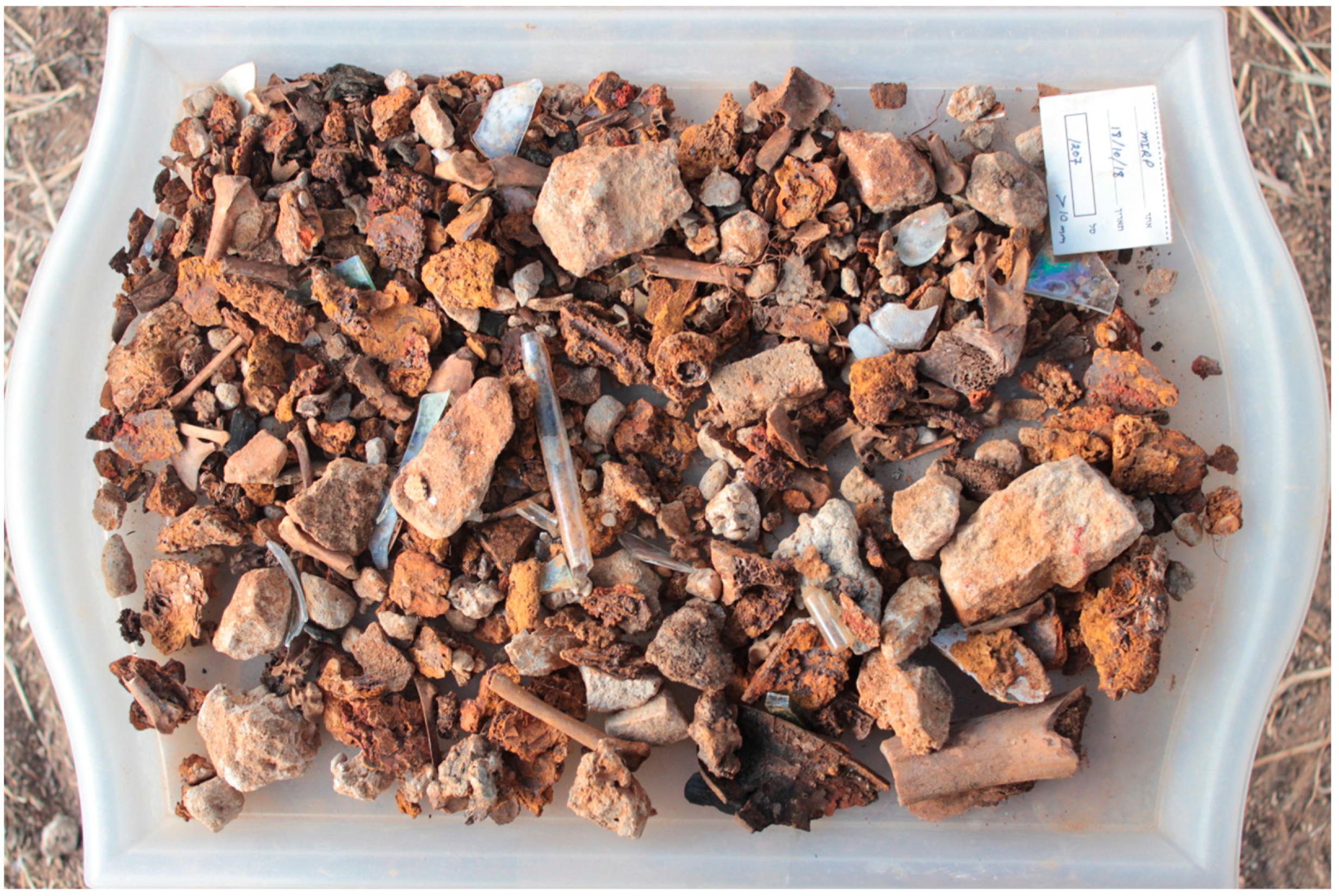
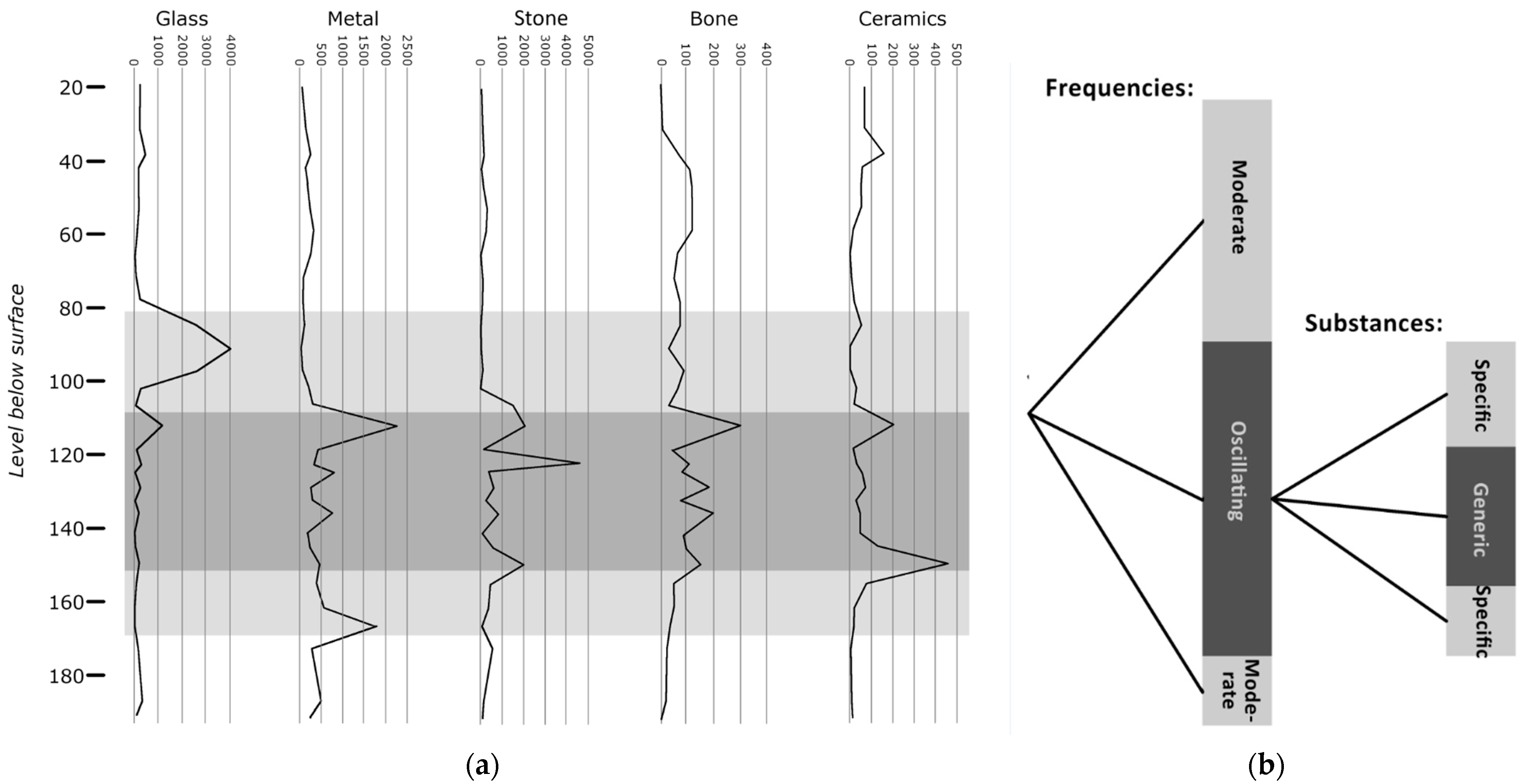
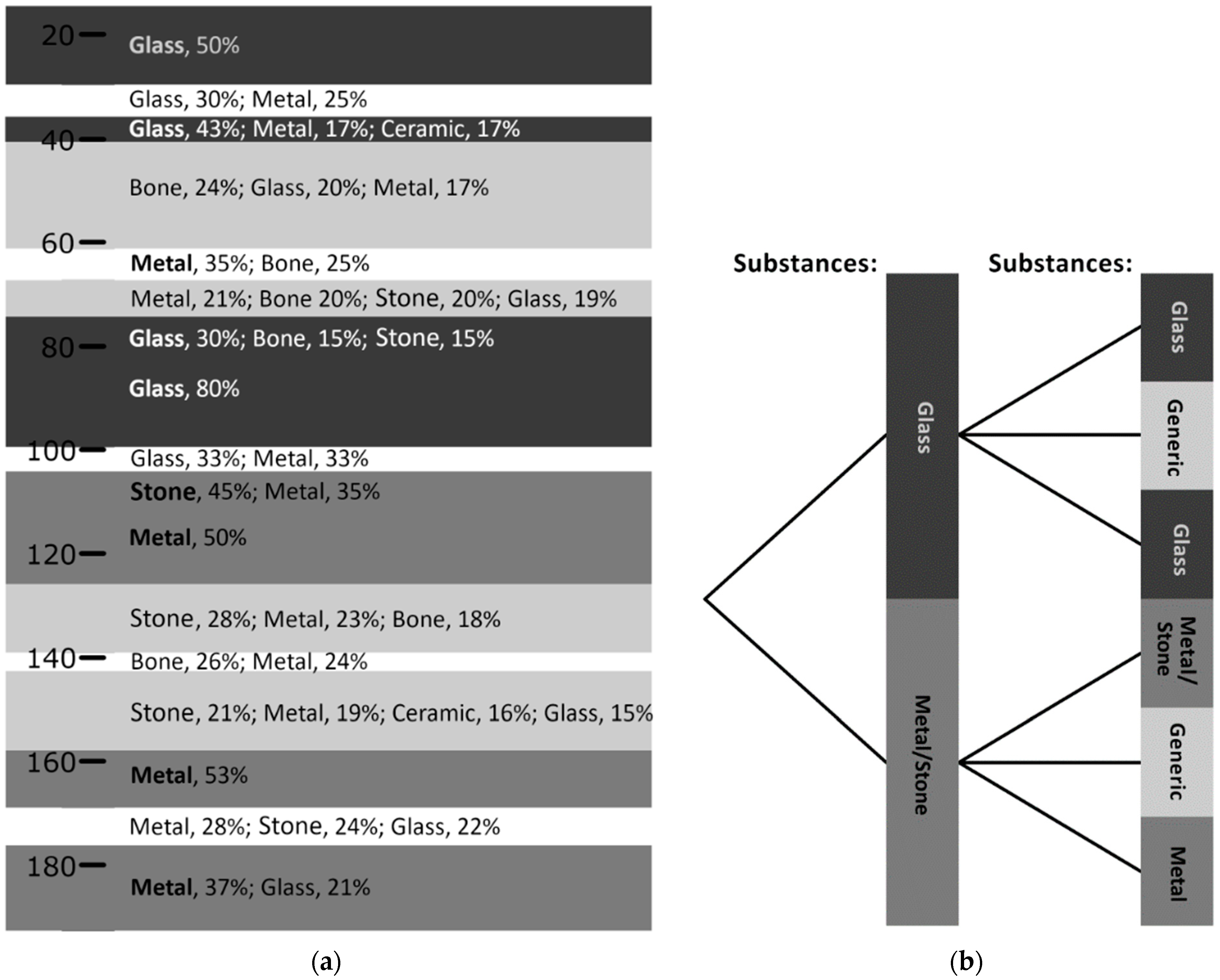
| Excavated Unit | Artifactual Content | ||||||
|---|---|---|---|---|---|---|---|
| Unit of Excavation | Top Elevations | Bottom Elevations | Excavated Volume (m3) | Description | Substance Categories | Ratio | Density (g/L) |
| 1002 | 20 | 17–36 | 0.26 | Brown, loose, somewhat ashy sediment; southwest part of Area. | Glass | 0.5 | 255.5 |
| Metal | 0.1 | 67.9 | |||||
| Bone | 0.035 | 4.5 | |||||
| Stone | 0.1 | 55.2 | |||||
| Ceramics | 0.15 | 70.7 | |||||
| Botanics | 0 | 0 | |||||
| Other | 0.055 | 10.9 | |||||
| 1003 | 17–36 | 22–42 | 0.26 | Same as above; tracing layer below. | Glass | 0.3 | 279.4 |
| Metal | 0.25 | 153.3 | |||||
| Bone | 0.02 | 10 | |||||
| Stone | 0.2 | 111.3 | |||||
| Ceramics | 0.2 | 72.1 | |||||
| Botanics | 0 | 0 | |||||
| Other | 0.03 | 7.7 | |||||
| 1004 | 18 | 47 | 0.32 | Brownish-yellow sediment; many finds demonstrate significant heat impact | Glass | 0.43 | 491.7 |
| Metal | 0.17 | 263.3 | |||||
| Bone | 0.09 | 69.8 | |||||
| Stone | 0.09 | 175.8 | |||||
| Ceramics | 0.17 | 159.2 | |||||
| Botanics | N/A | 0.05 | |||||
| Other | 0.05 | 31.6 | |||||
| 1005 | 37 | 49 | 0.12 | Sand mixed with ash; small patches of clean, sterile yellow sand. | Glass | 0.25 | 172.3 |
| Metal | 0.23 | 152.9 | |||||
| Bone | 0.27 | 106.6 | |||||
| Stone | 0.07 | 65.3 | |||||
| Ceramics | 0.12 | 58.7 | |||||
| Botanics | 0 | 0 | |||||
| Other | 0.06 | 14.6 | |||||
| 1009 | 41–44 | 53 | 0.08 | Sandy ash layer along southeast section | Glass | 0.2 | 179.7 |
| Metal | 0.15 | 206.8 | |||||
| Bone | 0.25 | 118.5 | |||||
| Stone | 0.15 | 153.8 | |||||
| Ceramics | 0.13 | 54.6 | |||||
| Botanics | N/A | 0.2 | |||||
| Other | 0.12 | 42.5 | |||||
| 1111 | 50 | 59 | 0.09 | Leveling; thick ash; reddish deposit in N corner; ash recedes to southeast | Glass | 0.19 | 198.8 |
| Metal | 0.18 | 258.9 | |||||
| Bone | 0.22 | 117.9 | |||||
| Stone | 0.21 | 326.9 | |||||
| Ceramics | 0.09 | 55.6 | |||||
| Botanics | 0.01 | 1 | |||||
| Other | 0.1 | 39.2 | |||||
| 1113 | 59 | 65–77 | 0.09 | Ash sediment and yellowish sandy layer around large iron/metal piece | Glass | 0.18 | 132.1 |
| Metal | 0.22 | 339.7 | |||||
| Bone | 0.22 | 117.3 | |||||
| Stone | 0.18 | 287.1 | |||||
| Ceramics | 0.04 | 16.2 | |||||
| Botanics | 0.06 | 6.82 | |||||
| Other | 0.1 | 32.2 | |||||
| 1116 | 62 | 70 | 0.08 | Yellow sand; contains significant amounts of metal and charred organic matter; basket closed upon encounter of mat/rag (?) | Glass | 0.09 | 18.5 |
| Metal | 0.35 | 282.1 | |||||
| Bone | 0.25 | 63.7 | |||||
| Stone | 0.1 | 45.9 | |||||
| Ceramics | 0.03 | 1.73 | |||||
| Botanics | 0.09 | 4.9 | |||||
| Other | 0.09 | 7.1 | |||||
| 1119 | 70 | 76 | 0.06 | Yellow sand below mat/fabric (including) | Glass | 0.19 | 65.9 |
| Metal | 0.21 | 103.3 | |||||
| Bone | 0.2 | 51.8 | |||||
| Stone | 0.2 | 138.5 | |||||
| Ceramics | 0.03 | 7.3 | |||||
| Botanics | 0.05 | 5.6 | |||||
| Other | 0.12 | 17 | |||||
| 1121 | 65 | 77–83 | 0.04 | Removal of sand layer, tracing ash below | Glass | 0.35 | 266.7 |
| Metal | 0.15 | 88.2 | |||||
| Bone | 0.25 | 73.9 | |||||
| Stone | 0.1 | 112.2 | |||||
| Ceramics | 0.05 | 19.7 | |||||
| Botanics | 0.04 | 1.8 | |||||
| Other | 0.06 | 14.4 | |||||
| 1151 | 82–83 | 88–91 | 0.08 | Densely packed glass bottle layer, associated with fine, loose, dark brown sediment | Glass | 0.8 | 2706.6 |
| Metal | 0.05 | 98.4 | |||||
| Bone | 0.05 | 73.1 | |||||
| Stone | 0.03 | 63.2 | |||||
| Ceramics | 0.05 | 54.6 | |||||
| Botanics | N/A | N/A | |||||
| Other | 0.02 | 19.1 | |||||
| 1152 | 88–91 | 94–100 | 0.08 | Dense ‘bottle layer’; sediment is loose brown with small patches of charcoal and organic residue | Glass | 0.8 | 4093.9 |
| Metal | 0.05 | 37.4 | |||||
| Bone | 0.05 | 30.4 | |||||
| Stone | 0.05 | 58.8 | |||||
| Ceramics | 0 | 0 | |||||
| Botanics | 0.01 | 2.2 | |||||
| Other | 0.04 | 14.5 | |||||
| 1155 | 100 | 101–105 | 0.015 | Leftover of ‘bottle layer’ on SW side of column | Glass | 0.65 | 2714.9 |
| Metal | 0.08 | 72.3 | |||||
| Bone | 0.12 | 86.5 | |||||
| Stone | 0.1 | 115.3 | |||||
| Ceramics | N/A | N/A | |||||
| Botanics | N/A | N/A | |||||
| Other | 0.05 | 20.9 | |||||
| 1156 | 96 | 102–104 | 0.035 | Leveling (mostly E side of column); reddish-brown sediment, a large amount of metal at lower part of unit, mostly towards northeast; large pieces of construction debris uncovered. | Glass | 0.33 | 311.2 |
| Metal | 0.33 | 197.3 | |||||
| Bone | 0.16 | 62.8 | |||||
| Stone | 0.06 | 59.6 | |||||
| Ceramics | 0.06 | 30.7 | |||||
| Botanics | 0.03 | 6.4 | |||||
| Other | 0.03 | 4.1 | |||||
| 1159 | 102–104 | 108–111 | 0.067 | Reddish-brown sediment, a considerable amount of metal and construction debris. | Glass | 0.06 | 102.8 |
| Metal | 0.35 | 306.6 | |||||
| Bone | 0.04 | 29.1 | |||||
| Stone | 0.45 | 1560 | |||||
| Ceramics | 0.025 | 19.9 | |||||
| Botanics | 0.02 | 4.4 | |||||
| Other | 0.055 | 24.1 | |||||
| 1186 | 108–111 | 110–116 | 0.013 | Cleanup and leveling; mostly metallic scraps; in the middle, pale reddish-brown fine sediment. | Glass | 0.2 | 1196.3 |
| Metal | 0.4 | 2298.8 | |||||
| Bone | 0.1 | 301.9 | |||||
| Stone | 0.2 | 2112.4 | |||||
| Ceramics | 0.04 | 206.7 | |||||
| Botanics | 0.01 | 2.4 | |||||
| Other | 0.05 | 116.7 | |||||
| 1187 | 110–116 | 116–120 | 0.053 | Removal of metallic layer, exposing silty reddish sediment below. Large cement block removed from S corner, brown ashy sediment below it. | Glass | 0.1 | 124 |
| Metal | 0.6 | 429.2 | |||||
| Bone | 0.1 | 41.6 | |||||
| Stone | 0.1 | 145.2 | |||||
| Ceramics | 0.05 | 16.4 | |||||
| Botanics | 0.02 | 0.4 | |||||
| Other | 0.03 | 1.57 | |||||
| 1188 | 116–120 | 119–123 | 0.024 | Fine, reddish, relatively compact sediment. South part of trench consists of amorphous metal pieces, while north part of trench has more sediment, ceramics, and stones. | Glass | 0.1 | 301.3 |
| Metal | 0.15 | 323 | |||||
| Bone | 0.1 | 109.3 | |||||
| Stone | 0.5 | 4652.1 | |||||
| Ceramics | 0.06 | 34.8 | |||||
| Botanics | 0.05 | 8.1 | |||||
| Other | 0.04 | 17.2 | |||||
| 1189 | 119–123 | 127–129 | 0.058 | Leftover of metal layer removed along with reddish silty deposit below. Along southeast section, sediment is yellowish-grey, although otherwise identical to abovementioned reddish deposit. | Glass | 0.06 | 62.7 |
| Metal | 0.36 | 807.2 | |||||
| Bone | 0.23 | 77.9 | |||||
| Stone | 0.23 | 434.1 | |||||
| Ceramics | 0.07 | 58.2 | |||||
| Botanics | 0.015 | 4.26 | |||||
| Other | 0.035 | 15.4 | |||||
| 1197 | 126–129 | 130–133 | 0.028 | Silty, moderately compact sediment. Yellowish-grey sediment with more gravel and construction debris in southeast part; more brown and reddish with bones and ceramics in northwest part. | Glass | 0.2 | 280.2 |
| Metal | 0.15 | 252 | |||||
| Bone | 0.2 | 180.2 | |||||
| Stone | 0.25 | 662.4 | |||||
| Ceramics | 0.1 | 74.6 | |||||
| Botanics | 0.03 | 3.4 | |||||
| Other | 0.07 | 36 | |||||
| 1198 | 130–133 | 132–138 | 0.024 | Fine silty sediment, variegated: yellow, reddish-brown, and grey. In northeast part, a large piece of tire (?) was exposed, along with fine whitish sediment (ash? plaster?) | Glass | 0.15 | 89.2 |
| Metal | 0.28 | 302.2 | |||||
| Bone | 0.2 | 73.9 | |||||
| Stone | 0.24 | 291.9 | |||||
| Ceramics | 0.07 | 32.2 | |||||
| Botanics | 0.03 | 7.5 | |||||
| Other | 0.03 | 5.79 | |||||
| 1199 | 132–138 | 137–142 | 0.027 | Fine, silty variegated sediment (as above) deposited upon fine yellowish sand. | Glass | 0.12 | 245.4 |
| Metal | 0.2 | 761.8 | |||||
| Bone | 0.16 | 196.6 | |||||
| Stone | 0.16 | 899.1 | |||||
| Ceramics | 0.07 | 51.8 | |||||
| Botanics | 0.06 | 5.2 | |||||
| Other | 0.07 | 49.7 | |||||
| 1200 | 137–142 | 140–144 | 0.022 | Fine yellow sand, superimposing a reddish-brown variegated deposit, which is much denser in finds. | Glass | 0.1 | 47.4 |
| Metal | 0.24 | 171.2 | |||||
| Bone | 0.26 | 83.2 | |||||
| Stone | 0.11 | 133.8 | |||||
| Ceramics | 0.11 | 49.6 | |||||
| Botanics | 0.04 | 2.8 | |||||
| Other | 0.14 | 61.5 | |||||
| 1206 | 140–144 | 147–151 | 0.052 | Dark brown, sometimes rusty, sediment. Feels as if finds are in comparatively good condition. | Glass | 0.08 | 101.3 |
| Metal | 0.24 | 245 | |||||
| Bone | 0.23 | 95.1 | |||||
| Stone | 0.23 | 613.6 | |||||
| Ceramics | 0.12 | 133.3 | |||||
| Botanics | 0.02 | 3.6 | |||||
| Other | 0.08 | 66.8 | |||||
| 1207 | 147–151 | 150–152 | 0.01 | Dark brown loose deposit, highly variegated with local concentrations of different finds (metal, bone, etc.). Seems to contain much organic matter. Quite airy. A more yellowish deposit begins cropping up over much of the square. | Glass | 0.15 | 253.3 |
| Metal | 0.17 | 467.6 | |||||
| Bone | 0.15 | 144.5 | |||||
| Stone | 0.22 | 2056.7 | |||||
| Ceramics | 0.18 | 458.9 | |||||
| Botanics | 0.04 | 4.7 | |||||
| Other | 0.09 | 62 | |||||
| 1208 | 153–154 | 158–161 | 0.042 | Alternating and mixed deposits of yellow sand and dark brown sediment. Finds are in relatively good condition. | Glass | 0.15 | 145 |
| Metal | 0.21 | 396 | |||||
| Bone | 0.11 | 46.5 | |||||
| Stone | 0.2 | 480.8 | |||||
| Ceramics | 0.13 | 81.2 | |||||
| Botanics | 0.02 | 7 | |||||
| Other | 0.18 | 70.8 | |||||
| 1209 | 158–161 | 163–166 | 0.037 | Variegated sandy/brown deposits, overlying a dense deposit of metals. | Glass | 0.09 | 59.6 |
| Metal | 0.35 | 566.6 | |||||
| Bone | 0.1 | 46.9 | |||||
| Stone | 0.15 | 383.6 | |||||
| Ceramics | 0.08 | 22.9 | |||||
| Botanics | 0.08 | 5.2 | |||||
| Other | 0.15 | 70.3 | |||||
| 1214 | 163–166 | 165–170 | 0.03 | Removal of dense metal layer, exposing below an uneven upper face of a sandy variegated deposit. | Glass | 0.04 | 33.4 |
| Metal | 0.7 | 1813.3 | |||||
| Bone | 0.08 | 29.7 | |||||
| Stone | 0.05 | 93.6 | |||||
| Ceramics | 0.03 | 21.2 | |||||
| Botanics | 0.02 | 2.9 | |||||
| Other | 0.08 | 38.4 | |||||
| 1215 | 165–170 | 170–177 | 0.045 | Variegated sandy deposit. Pale grey (cement-like) deposit, relatively dense in northeast part of trench. In southwest part, below dark brown-reddish sediment, the same pale grey sediment was exposed, but with numerous finds. Near southern corner, a concentration of charred matter was noted. Against southeast section, a tin vessel was exposed. | Glass | 0.24 | 208.1 |
| Metal | 0.27 | 279.2 | |||||
| Bone | 0.07 | 19.1 | |||||
| Stone | 0.24 | 615.1 | |||||
| Ceramics | 0.03 | 6.2 | |||||
| Botanics | 0.04 | 6.2 | |||||
| Other | 0.09 | 17.1 | |||||
| 1217 | 174–187 | 187–192 | 0.075 | A deposit of metal and organic (?) substances. It is loose and airy. In south corner, a small patch of lime-like sediment and construction debris. There are also many roots in this layer. Below it is a relatively dense silty sediment, reddish-brown. | Glass | 0.23 | 376.4 |
| Metal | 0.35 | 512.1 | |||||
| Bone | 0.07 | 17.2 | |||||
| Stone | 0.12 | 197.2 | |||||
| Ceramics | 0.04 | 11.5 | |||||
| Botanics | 0.07 | 9.9 | |||||
| Other | 0.12 | 24.8 | |||||
| 1218 | 187–192 | 190–193 | 0.016 | Exposing hamra layer; variegated deposit, leftovers of previous ones. | Glass | 0.2 | 99.5 |
| Metal | 0.4 | 274.5 | |||||
| Bone | 0.03 | 2.5 | |||||
| Stone | 0.15 | 158.3 | |||||
| Ceramics | 0.06 | 11.9 | |||||
| Botanics | 0.06 | 6.8 | |||||
| Other | 0.1 | 17.6 | |||||
Publisher’s Note: MDPI stays neutral with regard to jurisdictional claims in published maps and institutional affiliations. |
© 2022 by the author. Licensee MDPI, Basel, Switzerland. This article is an open access article distributed under the terms and conditions of the Creative Commons Attribution (CC BY) license (https://creativecommons.org/licenses/by/4.0/).
Share and Cite
Nativ, A. A Case for Buried Culture: From an Unknown Known to a Known Unknown. Humans 2022, 2, 74-94. https://doi.org/10.3390/humans2030006
Nativ A. A Case for Buried Culture: From an Unknown Known to a Known Unknown. Humans. 2022; 2(3):74-94. https://doi.org/10.3390/humans2030006
Chicago/Turabian StyleNativ, Assaf. 2022. "A Case for Buried Culture: From an Unknown Known to a Known Unknown" Humans 2, no. 3: 74-94. https://doi.org/10.3390/humans2030006
APA StyleNativ, A. (2022). A Case for Buried Culture: From an Unknown Known to a Known Unknown. Humans, 2(3), 74-94. https://doi.org/10.3390/humans2030006






